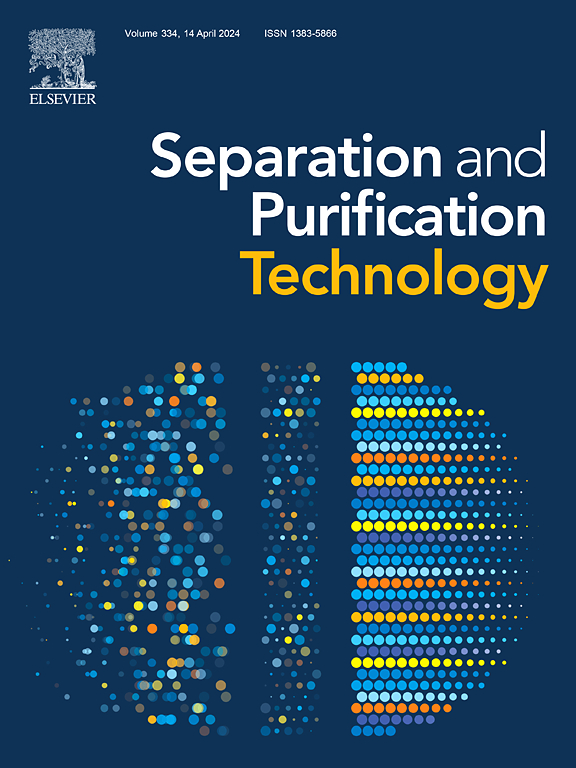磁性MoS2-Fe3O4纳米复合材料对水中啶虫啉的双功能吸附和光催化去除
IF 8.1
1区 工程技术
Q1 ENGINEERING, CHEMICAL
引用次数: 0
摘要
新烟碱类农药乙酰氨脒(aceamiprid, ACE)在水生环境中持续被检测到,由于其化学稳定性和水溶性,需要开发更有效的修复策略。本文合成了磁性MoS2-Fe3O4纳米复合材料,用于吸附和光催化去除ACE。在预先合成的MoS2纳米片上,采用溶剂热生长法制备了两种质量比分别为5:1 (MF-5:1)和2:1 (MF-2:1)的MoS2: Fe3O4复合材料,并利用XRD、FTIR、XPS、SEM、TEM和电化学技术对其进行了表征。MF-5:1表现出优异的性能,在UV-VIS照射3 h后去除55 %的ACE(10 ppm),在重复使用三次后仍保持40 %的效率。Langmuir等温线分析显示,MoS2的最大吸附容量为26.1 mg g−1,MF-5:1的最大吸附容量为19.2 mg g−1,超过了许多传统吸附剂的报道值。Fe3O4的掺入虽然会使吸附容量略有降低,但会使磁分离成为可能,有利于物料的回收。光电流和莫特-肖特基分析证实了电荷分离和供体密度的增强,有助于提高光催化活性。这些发现证明了MoS2-Fe3O4纳米复合材料作为多功能、磁性可回收的农药去除材料的潜力,并为研究与环境修复技术相关的表面和电荷传输特性提供了新的见解。本文章由计算机程序翻译,如有差异,请以英文原文为准。

Magnetic MoS2–Fe3O4 nanocomposites for dual-function adsorption and photocatalytic removal of acetamiprid from water
The persistent detection of the neonicotinoid pesticide acetamiprid (ACE) in aquatic environments, driven by its chemical stability and water solubility, necessitates the development of more efficient remediation strategies. In this work, magnetic MoS2–Fe3O4 nanocomposites were synthesized for the combined adsorption and photocatalytic removal of ACE. Two composites with MoS2: Fe3O4 mass ratios of 5:1 (MF-5:1) and 2:1 (MF-2:1) were prepared by solvothermal growth of Fe3O4 on pre-synthesized MoS2 nanosheets and characterized using XRD, FTIR, XPS, SEM, TEM, and electrochemical techniques. MF-5:1 exhibited superior performance, removing 55 % of ACE (10 ppm) after 3 h of UV–VIS irradiation and retaining 40 % efficiency after three reuse cycles. Langmuir isotherm analysis revealed maximum adsorption capacities of 26.1 mg g−1 for MoS2 and 19.2 mg g−1 for MF-5:1, exceeding values reported for many conventional adsorbents. Although Fe3O4 incorporation slightly reduced adsorption capacity, it enabled magnetic separation, facilitating material recovery. Photocurrent and Mott–Schottky analyses confirmed enhanced charge separation and donor density, contributing to improved photocatalytic activity. These findings demonstrate the potential of MoS2–Fe3O4 nanocomposites as multifunctional, magnetically recoverable materials for pesticide removal and provide new insights into surface and charge transport properties relevant to environmental remediation technologies.
求助全文
通过发布文献求助,成功后即可免费获取论文全文。
去求助
来源期刊

Separation and Purification Technology
工程技术-工程:化工
CiteScore
14.00
自引率
12.80%
发文量
2347
审稿时长
43 days
期刊介绍:
Separation and Purification Technology is a premier journal committed to sharing innovative methods for separation and purification in chemical and environmental engineering, encompassing both homogeneous solutions and heterogeneous mixtures. Our scope includes the separation and/or purification of liquids, vapors, and gases, as well as carbon capture and separation techniques. However, it's important to note that methods solely intended for analytical purposes are not within the scope of the journal. Additionally, disciplines such as soil science, polymer science, and metallurgy fall outside the purview of Separation and Purification Technology. Join us in advancing the field of separation and purification methods for sustainable solutions in chemical and environmental engineering.
 求助内容:
求助内容: 应助结果提醒方式:
应助结果提醒方式:


